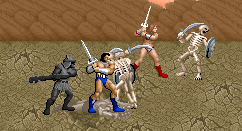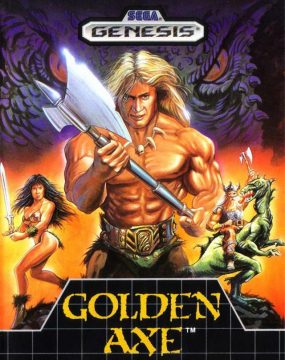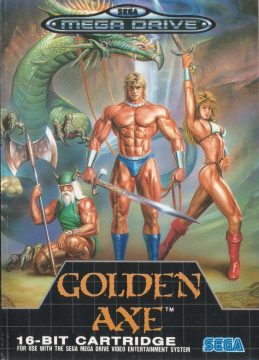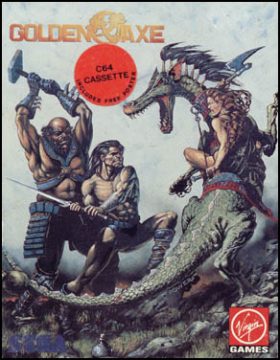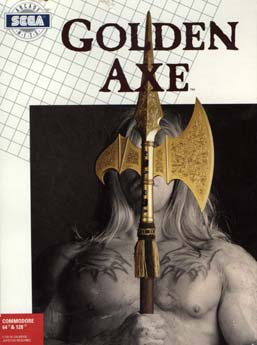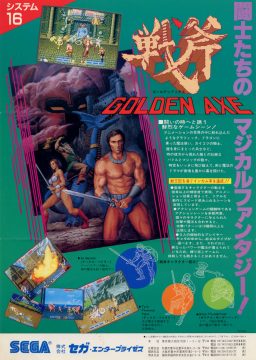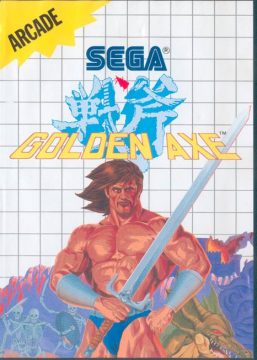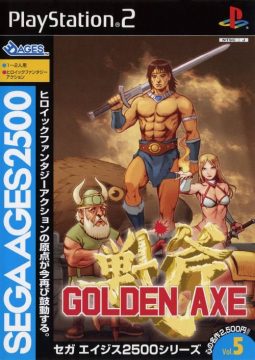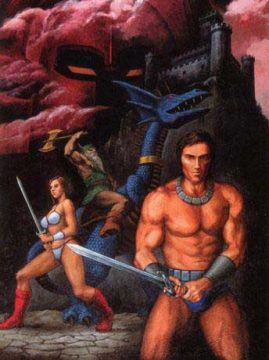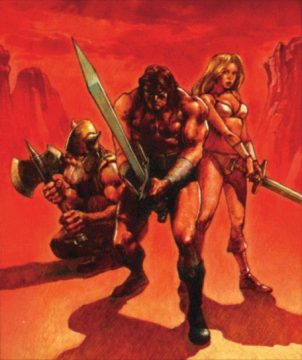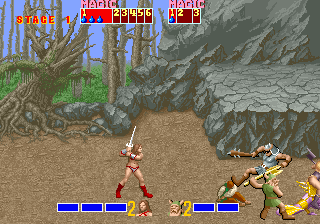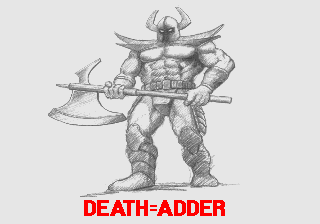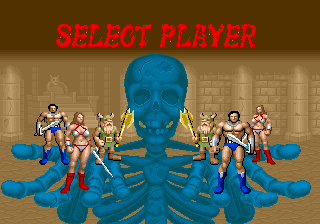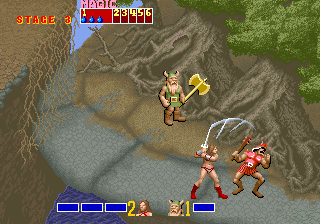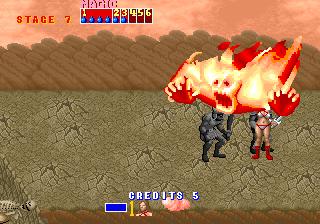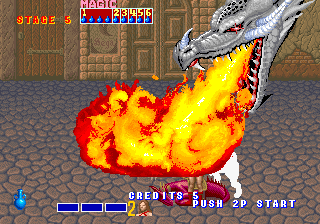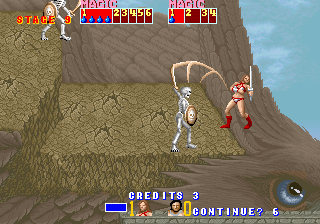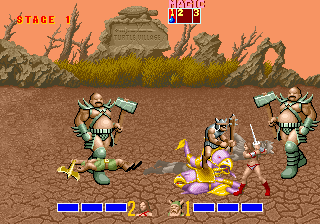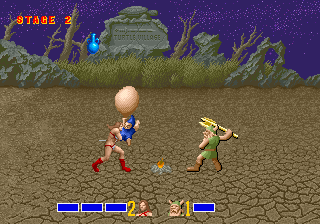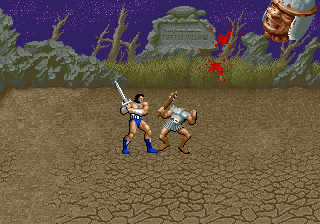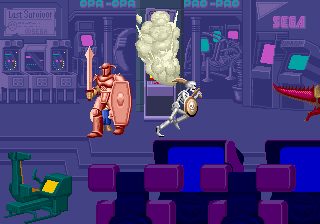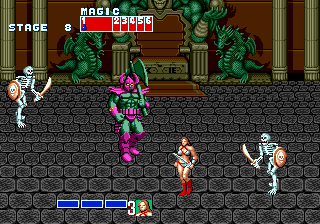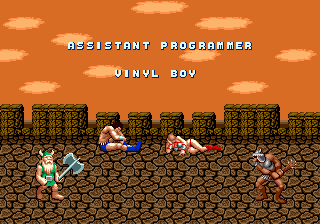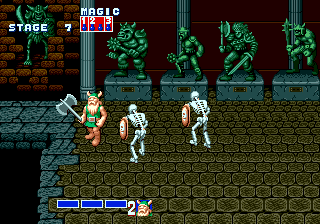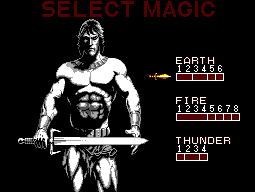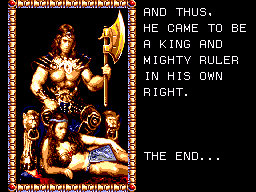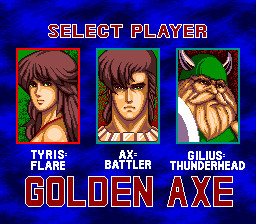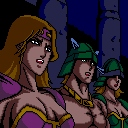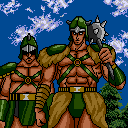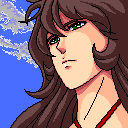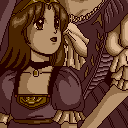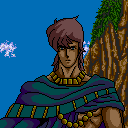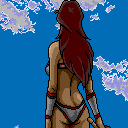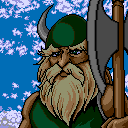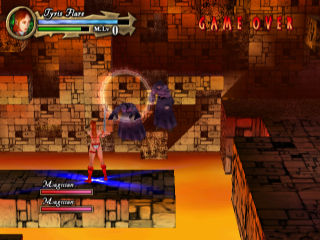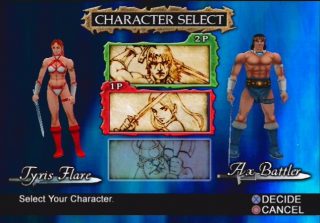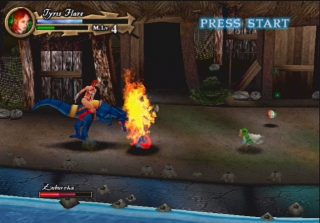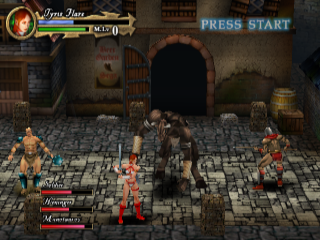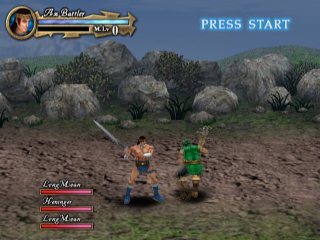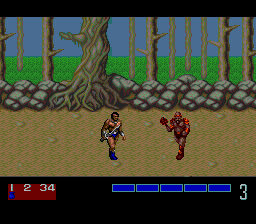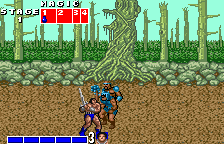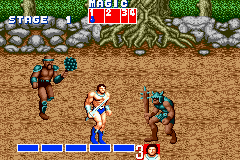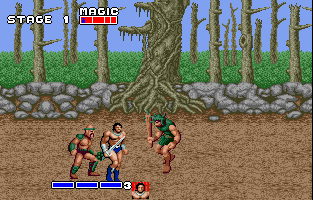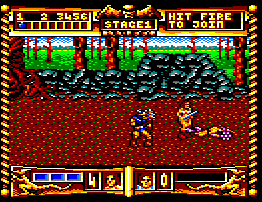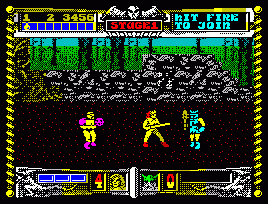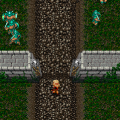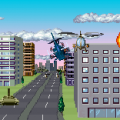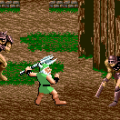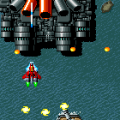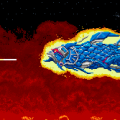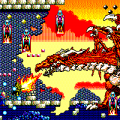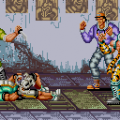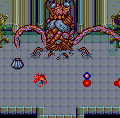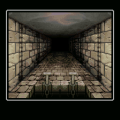The Golden Axe series was created by Makoto Uchida (Altered Beast, Dynamite Cop). It’s a barbarian themed beat-em-up that’s heavily inspired by the Conan the Barbarian stories, featuring buff warriors in tights and Red Sonja-style warrior goddesses in bikinis. The series is also known for its fantastic artwork which resembles classic Conan the Barbarian and Frank Frazetta work, though a lot of other fantasy action games borrow from these as well.
The whole series tells a tale about a mythical weapon called Golden Axe that can grant its user great power (the Japanese characters in the Golden Axe logo roughly translate to “Battle Axe“ – there’s a sword, a hammer, and an axe hidden inside the stylized kanji). The main antagonist is an evil lord called Death Adder, a towering monstrosity of a man who wears a frightening mask just to let the player know he’s evil. It started as an arcade game, which later spawned two sequels for the Genesis, and another sequel for the arcade. There are also several spin-offs outside of the main series, including two role-playing games and a 2D fighter.
Characters
There are three characters to play as: Ax Battler is a typical super muscular barbarian, and an all-round average fighter; Tyris Flare is the bikini armor-clad Amazon, the princess of the kingdom, and fantastic magic user; and Gilius Thunderhead is a dwarf. Despite his diminutive stature he’s the strongest, but has the weakest magic power. Gilius Thunderhead’s initial attack is also the slowest of the three characters.
The gameplay of Golden Axe is fast paced and typical of most beat-em-ups. There’s a single attack button, a jump button, and a magic button. Repeatedly hitting an enemy using the attack button will begin a combo that the player can end by either throwing the enemy away from them, or by hitting them with the blunt end of their weapon for extra damage. It’s a particularly brutal animation (for the time) that keeps the game true to its barbarian inspiration.
Pressing attack and jump at the same time lets you attack behind you. You can also dash forward by double tapping the joystick. Finally, if you run, jump, and press attack at the peak of your ascent you’ll do a downward stab. This is very difficult to hit anything with, but will kill most non-boss enemies with a single strike. The striking nature of the animation is helped by the fact that, unlike almost every other beat-em-up you’ll find, enemy bodies remain on the screen forever after being defeated.
Each level is also filled with little gnomes, which drop magical pots when they’re hit. Although the type of magic depends on the character, the number of pots you have determines which level of spell you can cast. All of them will attack every enemy on the screen, but the spell level will determine how much damage it’ll do. Naturally, the stronger the spell, the cooler the effect. On a low level, Tyris Flare will summon flaming ghosts to wail around the screen. At a higher level, she’ll summon a dragon to breath fire on everything. It’s a quick and easy way to damage bosses, and keep the crowds of enemies under control. Between each level, a bonus round is initiated, where these same gnomes come and steal your magic while you’re camping for the night. You have the opportunity to get back more magic than you lost though, by efficiently beating up the gnomes for their trouble.
After these bonus rounds, each new level begins with one of the characters writing in a journal, describing their adventure into the lair of Death Adder. The game world itself is pretty cool and remarkably well developed – one village is on the back of a giant turtle, and at another point you actually board the back of a gigantic bird. The stages are filled with various kinds of barbarians, including a pair of fat bald-headed dudes with hammers known as the Bad Brothers. There are also animated Ray Harryhausen-style skeletons, who are some of the toughest foes in the game.
Most beat-em-ups grant you power-ups in the form of weapons, effectively doubling your strength. Since all of the players in Golden Axe already have weapons, the game goes one step further and lets you ride on a variety of beasts known as Bizarrians. These include a cockatrice-like creature (known as “Chicken Leg“) that whips enemies with its tail (taken from Altered Beast), as well as two different types of dragons. The first breathes a fiery jet of flame, the second type only appears at the beginning of level three and attacks by spitting a fireball clear across the screen.
At the end of the game, you’re also ranked via on obscure scoring system. The easiest way to obtain a high score, other than reducing the number of deaths, is by slaying an enemy, then repeatedly killing them with magic attacks before they hit the ground.
The color palette is a bit dull, mostly consisting of brown, shades of brown, and more brown. That’s not to say it looks bland though – the backgrounds are well detailed, and the enemies look pretty cool, even though they’re limited in number.
The music is composed by Tohru Nakabayashi (Thunder Blade) and resembles Conan The Barbarian in almost every way. There are also a ton of cool, cheesy digitized screams lifted from movies like First Blood and Conan. The most memorable one is the “OH GAWD!“ sound clip from when David Caruso’s character is attacked in First Blood. Compare this to Final Fight, which just had generic grunts and groans. The Japanese version has blood dripping from the letters on the “PLAYER SELECT“ menu, and a brief demo where Ax Battler decapitates an enemy and sends his head flying towards the screen, which were both removed from overseas releases.
The arcade version has a totally awesome ending: it begins with the Golden Axe flying out of Death Adder’s hands and then landing in his gut, causing a bloody shower. After releasing the King and Queen the scene then changes to the cast of Golden Axe busting out of the arcade game and into the real world. Such strange endings were not out of place in some of Sega’s older arcade games – Altered Beast had a similarly light-hearted finale.
Far and away the best port was released as part of the Sega Vintage Collection in 2012, which is an arcade perfect translation with numerous graphics options and tweaks, along with online play. This version replaces the earlier XBLA release, which suffered from muddy upscaled and filtered graphics.
The Genesis port is well regarded. Everything is scaled down (immediately noticeable is that now the bodies disappear and several voice samples are missing), but its controls are very close to the original. An extra final level has also been added after defeating Death Adder, which culminates in a battle against an extremely aggravating foe known as Doom Bringer. In addition to being far more powerful than any previous boss, he also has two (nearly) invincible skeletons assisting him. Furthermore, every time you get knocked down, Doom Bringer performs one of several magical attacks just as powerful as your own.
Some parts are censored. The intro where you see Alex die was removed and replaced by the hero explaining the story, while the “Sega Beer Barn“ in Turtle Village was also removed. The few instances of blood were cut, and the ending has been changed to something significantly more generic. It also adds a mode called “The Duel“, where you either fight through stages of increasingly difficult groups of foes, or engage another player in one-on-one combat. This port is two-player and was re-released on the Genesis in a package called Sega 6 Pack. The Genesis port also appears in emulated form on the Windows and Dreamcast versions of the Sega Smash Pack, on the PS2 and PSP releases of the Sega Genesis Collection, and on Sonic’s Ultimate Genesis Collection for the PS3 and Xbox 360. The Dreamcast port, like most of the games on the disc, suffers from terrible sound emulation.
Golden Axe was also released on the Sega CD, in a compilation that came packaged with the original release of the unit. It’s basically just like the Genesis version, except most of the voice samples have changed, and the sound effect quality in general is worse. However, all of the music is redbook audio that streams from the disc, the only game on the compilation to do so. Oddly enough, this version is only single-player even though the version of Streets of Rage on the disc has two-player support.
The Sega Master System version is more or less a tragedy. You can only play as Ax Battler, renamed here as Tarik, though you can choose to use the type of magic attacks during the game. Pretty much everything is pathetic – it has ugly graphics, terribly choppy animation, and awful control. It also removes the two-player option. It does have a new intro and ending not found in any other version, at least.
The PC Engine CD port is a shame, and another disc full of broken dreams and mediocrity from the masters at Telenet. It’s completely horrendous, and almost as bad as the Master System version – miscolored graphics, a lack of background details, plus awful animation and controls. There are some poorly animated cutscenes that introduce each character’s backstory, along with some terrible remixed tunes. It’s only single-player too.
The WonderSwan Color version is fairly reasonable, given the limited hardware, but it’s more difficult. Enemies only attack in pairs but are much, much more aggressive than in any other version of the game. It has some very colorful graphics and okay sound. Many of the moves look different cosmetically but are the same from a gameplay standpoint. You can still run (and therefore do the running attack and running jump attack), but you can now only attack once in mid-air.
The home computer versions are of varying quality. The graphics on the Amstrad are especially blocky and the character animations are off too. The Commodore 64 version does have some excellent music provided by Jeroen Tel. The IBM PC version changes the health icons into gems for some reason, and also the character icons. The Amiga and Atari ST versions have excellent music and graphics that are roughly on the same level as the Genesis version.
Golden Axe was also released on the Game Boy Advance as one of three games on a Sega Smash Pack compilation (along with Sonic Spinball and Ecco the Dolphin). This version is very poorly coded, with muddy sound and only two songs that alternate from the start to the end. The hit detection is also very inconsistent, and the proportions for the characters were changed to fit the smaller screen, so it’s quite cramped. It’s also missing two player mode for the main game.
Golden Axe was also one of the first games to be remade as part of the Sega Ages line for the PS2. The initial goal of this series was to produce budget versions of classic Sega games, but with 3D graphics. The series received a lot of flack in its early years, and most of that is due to the Golden Axe remake, which is a total embarrassment. The character models are terrible and the backgrounds look worse than the original game. Even if you don’t mind the visuals, the game just doesn’t feel right. Each sword strike gives off a huge explosion, which looks cool at first, but also obscures the action. While being able to attack vertically is nice, the combos don’t feel right either. Plus, the enemies are absurdly stupid, often just walking around aimlessly and giving you plenty of time to damage them.
There are now cutscenes, which mostly just show how ugly the characters are, while replacing the little drawn maps and journals of the original. You still get magic bottles from beating up thieves, but you also regenerate magic automatically by pounding on bad guys. Enemies also have names and life bars now, for all the good that does.
Many of the levels have been expanded, but it mostly just results in padded, pointlessly long areas. There are nine levels in total, with a few extra locations, including a river area and a basement underneath Death Adder’s castle similar to the one in the Genesis version, filled with lava pits and teleporting magicians. The only real plus to this version is the arranged soundtrack, which is quite good.
Screenshot Comparisons
